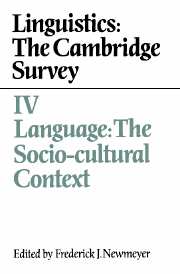Book contents
- Frontmatter
- Contents
- Contributors
- Preface
- 1 The study of language in its socio-cultural context
- 2 Language, culture, and world-view
- 3 Language and social class
- 4 Language and race: some implications for linguistic science
- 5 Language and gender
- 6 Bilingualism
- 7 Dialectology
- 8 Sociolinguistics and syntactic variation
- 9 Language birth: the processes of pidginization and creolization
- 10 Language death
- 11 Language planning: the view from linguistics
- 12 Ethnography of speaking: toward a linguistics of the praxis
- 13 The organization of discourse
- 14 Conversation analysis
- Index of names
- Index of subjects
- Contents of Volumes I, II, and III
12 - Ethnography of speaking: toward a linguistics of the praxis
Published online by Cambridge University Press: 05 June 2012
- Frontmatter
- Contents
- Contributors
- Preface
- 1 The study of language in its socio-cultural context
- 2 Language, culture, and world-view
- 3 Language and social class
- 4 Language and race: some implications for linguistic science
- 5 Language and gender
- 6 Bilingualism
- 7 Dialectology
- 8 Sociolinguistics and syntactic variation
- 9 Language birth: the processes of pidginization and creolization
- 10 Language death
- 11 Language planning: the view from linguistics
- 12 Ethnography of speaking: toward a linguistics of the praxis
- 13 The organization of discourse
- 14 Conversation analysis
- Index of names
- Index of subjects
- Contents of Volumes I, II, and III
Summary
Introduction
The ethnography of speaking (henceforth ES) studies language use as displayed in the daily life of particular speech communities. Its method is ethnography, supplemented by techniques developed in other areas of study such as developmental pragmatics, conversation analysis, poetics, and history. Its theoretical contributions are centered around the study of situated discourse, that is, linguistic performance as the locus of the relationship between language and the socio-cultural order.
From the point of view of the content of daily verbal interaction, ES is interested in the relationship between language use and local systems of knowledge and social conduct. ES views discourse as one of the main loci for the (re)creation and transmission of cultural patterns of knowledge and social action. More specifically, ES studies what is accomplished through speaking and how speech is related to and is constructed by particular aspects of social organization and speakers' assumptions, values, and beliefs about the world. The meaning of speech for particular speakers in specific social activities is thus a central concern for ES. Some typical questions asked by ethnographers of speaking in analyzing a particular strip of verbal interaction are: what is the goal of speech in this case? Which attributes of the linguistic code warrant its use in this context? What is the relation of this interaction to other, similar acts performed by the same actors or to other events observed in the same community?
With respect to the form of daily language use, ES has been focussing on patterns of variation across socio-cultural contexts, both within and across societies, with particular emphasis on the interrelation of the emergent and the culturally predictable structure of verbal performance in the conduct of social life.
- Type
- Chapter
- Information
- Linguistics: The Cambridge Survey , pp. 210 - 228Publisher: Cambridge University PressPrint publication year: 1988
- 17
- Cited by



